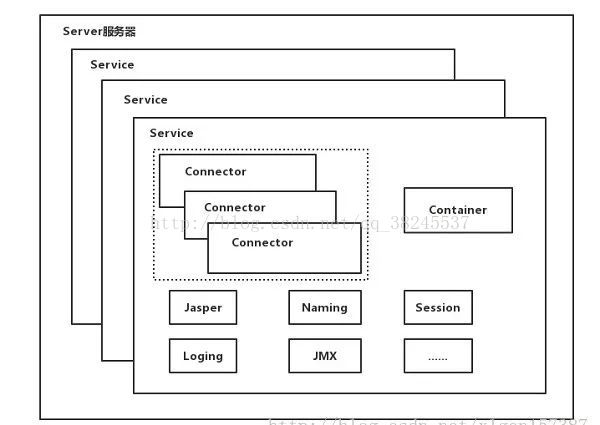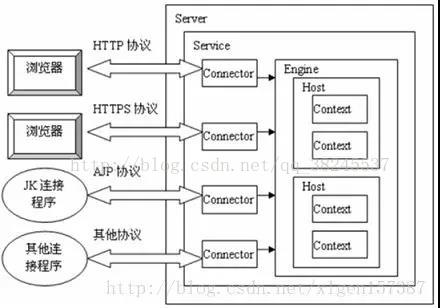SpringBoot内置tomcat启动原理
前言
不得不说SpringBoot的开发者是在为大众程序猿谋福利,把大家都惯成了懒汉,xml不配置了,连tomcat也懒的配置了,典型的一键启动系统,那么tomcat在springboot是怎么启动的呢?
内置tomcat
开发阶段对我们来说使用内置的tomcat是非常够用了,当然也可以使用jetty。
<dependency>
<groupId>org.springframework.boot</groupId>
<artifactId>spring-boot-starter-web</artifactId>
<version>2.1.6.RELEASE</version>
</dependency>
@SpringBootApplication
public class MySpringbootTomcatStarter{
public static void main(String[] args) {
Long time=System.currentTimeMillis();
SpringApplication.run(MySpringbootTomcatStarter.class);
System.out.println("===应用启动耗时:"+(System.currentTimeMillis()-time)+"===");
}
}
这里是main函数入口,两句代码最耀眼,分别是SpringBootApplication注解和SpringApplication.run()方法。
发布生产
发布的时候,目前大多数的做法还是排除内置的tomcat,打瓦包(war)然后部署在生产的tomcat中,好吧,那打包的时候应该怎么处理?
<dependency>
<groupId>org.springframework.boot</groupId>
<artifactId>spring-boot-starter-web</artifactId>
<!-- 移除嵌入式tomcat插件 -->
<exclusions>
<exclusion>
<groupId>org.springframework.boot</groupId>
<artifactId>spring-boot-starter-tomcat</artifactId>
</exclusion>
</exclusions>
</dependency>
<!--添加servlet-api依赖--->
<dependency>
<groupId>javax.servlet</groupId>
<artifactId>javax.servlet-api</artifactId>
<version>3.1.0</version>
<scope>provided</scope>
</dependency>
更新main函数,主要是继承SpringBootServletInitializer,并重写configure()方法。
@SpringBootApplication
public class MySpringbootTomcatStarter extends SpringBootServletInitializer {
public static void main(String[] args) {
Long time=System.currentTimeMillis();
SpringApplication.run(MySpringbootTomcatStarter.class);
System.out.println("===应用启动耗时:"+(System.currentTimeMillis()-time)+"===");
}
@Override
protected SpringApplicationBuilder configure(SpringApplicationBuilder builder) {
return builder.sources(this.getClass());
}
}
从main函数说起
public static ConfigurableApplicationContext run(Class<?> primarySource, String... args) {
return run(new Class[]{primarySource}, args);
}
--这里run方法返回的是ConfigurableApplicationContext
public static ConfigurableApplicationContext run(Class<?>[] primarySources, String[] args) {
return (new SpringApplication(primarySources)).run(args);
}
public ConfigurableApplicationContext run(String... args) {
ConfigurableApplicationContext context = null;
Collection<SpringBootExceptionReporter> exceptionReporters = new ArrayList();
this.configureHeadlessProperty();
SpringApplicationRunListeners listeners = this.getRunListeners(args);
listeners.starting();
Collection exceptionReporters;
try {
ApplicationArguments applicationArguments = new DefaultApplicationArguments(args);
ConfigurableEnvironment environment = this.prepareEnvironment(listeners, applicationArguments);
this.configureIgnoreBeanInfo(environment);
//打印banner,这里你可以自己涂鸦一下,换成自己项目的logo
Banner printedBanner = this.printBanner(environment);
//创建应用上下文
context = this.createApplicationContext();
exceptionReporters = this.getSpringFactoriesInstances(SpringBootExceptionReporter.class, new Class[]{ConfigurableApplicationContext.class}, context);
//预处理上下文
this.prepareContext(context, environment, listeners, applicationArguments, printedBanner);
//刷新上下文
this.refreshContext(context);
//再刷新上下文
this.afterRefresh(context, applicationArguments);
listeners.started(context);
this.callRunners(context, applicationArguments);
} catch (Throwable var10) {
}
try {
listeners.running(context);
return context;
} catch (Throwable var9) {
}
}
既然我们想知道tomcat在SpringBoot中是怎么启动的,那么run方法中,重点关注创建应用上下文(createApplicationContext)和刷新上下文(refreshContext)。
创建上下文
//创建上下文
protected ConfigurableApplicationContext createApplicationContext() {
Class<?> contextClass = this.applicationContextClass;
if (contextClass == null) {
try {
switch(this.webApplicationType) {
case SERVLET:
//创建AnnotationConfigServletWebServerApplicationContext
contextClass = Class.forName("org.springframework.boot.web.servlet.context.AnnotationConfigServletWebServerApplicationContext");
break;
case REACTIVE:
contextClass = Class.forName("org.springframework.boot.web.reactive.context.AnnotationConfigReactiveWebServerApplicationContext");
break;
default:
contextClass = Class.forName("org.springframework.context.annotation.AnnotationConfigApplicationContext");
}
} catch (ClassNotFoundException var3) {
throw new IllegalStateException("Unable create a default ApplicationContext, please specify an ApplicationContextClass", var3);
}
}
return (ConfigurableApplicationContext)BeanUtils.instantiateClass(contextClass);
}
这里会创建AnnotationConfigServletWebServerApplicationContext类。
而AnnotationConfigServletWebServerApplicationContext类继承了ServletWebServerApplicationContext,而这个类是最终集成了AbstractApplicationContext。
刷新上下文
//SpringApplication.java
//刷新上下文
private void refreshContext(ConfigurableApplicationContext context) {
this.refresh(context);
if (this.registerShutdownHook) {
try {
context.registerShutdownHook();
} catch (AccessControlException var3) {
}
}
}
//这里直接调用最终父类AbstractApplicationContext.refresh()方法
protected void refresh(ApplicationContext applicationContext) {
((AbstractApplicationContext)applicationContext).refresh();
}
//AbstractApplicationContext.java
public void refresh() throws BeansException, IllegalStateException {
synchronized(this.startupShutdownMonitor) {
this.prepareRefresh();
ConfigurableListableBeanFactory beanFactory = this.obtainFreshBeanFactory();
this.prepareBeanFactory(beanFactory);
try {
this.postProcessBeanFactory(beanFactory);
this.invokeBeanFactoryPostProcessors(beanFactory);
this.registerBeanPostProcessors(beanFactory);
this.initMessageSource();
this.initApplicationEventMulticaster();
//调用各个子类的onRefresh()方法,也就说这里要回到子类:ServletWebServerApplicationContext,调用该类的onRefresh()方法
this.onRefresh();
this.registerListeners();
this.finishBeanFactoryInitialization(beanFactory);
this.finishRefresh();
} catch (BeansException var9) {
this.destroyBeans();
this.cancelRefresh(var9);
throw var9;
} finally {
this.resetCommonCaches();
}
}
}
//ServletWebServerApplicationContext.java
//在这个方法里看到了熟悉的面孔,this.createWebServer,神秘的面纱就要揭开了。
protected void onRefresh() {
super.onRefresh();
try {
this.createWebServer();
} catch (Throwable var2) {
}
}
//ServletWebServerApplicationContext.java
//这里是创建webServer,但是还没有启动tomcat,这里是通过ServletWebServerFactory创建,那么接着看下ServletWebServerFactory
private void createWebServer() {
WebServer webServer = this.webServer;
ServletContext servletContext = this.getServletContext();
if (webServer == null && servletContext == null) {
ServletWebServerFactory factory = this.getWebServerFactory();
this.webServer = factory.getWebServer(new ServletContextInitializer[]{this.getSelfInitializer()});
} else if (servletContext != null) {
try {
this.getSelfInitializer().onStartup(servletContext);
} catch (ServletException var4) {
}
}
this.initPropertySources();
}
//接口
public interface ServletWebServerFactory {
WebServer getWebServer(ServletContextInitializer... initializers);
}
//实现
AbstractServletWebServerFactory
JettyServletWebServerFactory
TomcatServletWebServerFactory
UndertowServletWebServerFactory
这里ServletWebServerFactory接口有4个实现类

而其中我们常用的有两个:TomcatServletWebServerFactory和JettyServletWebServerFactory。
//TomcatServletWebServerFactory.java
//这里我们使用的tomcat,所以我们查看TomcatServletWebServerFactory。到这里总算是看到了tomcat的踪迹。
@Override
public WebServer getWebServer(ServletContextInitializer... initializers) {
Tomcat tomcat = new Tomcat();
File baseDir = (this.baseDirectory != null) ? this.baseDirectory : createTempDir("tomcat");
tomcat.setBaseDir(baseDir.getAbsolutePath());
//创建Connector对象
Connector connector = new Connector(this.protocol);
tomcat.getService().addConnector(connector);
customizeConnector(connector);
tomcat.setConnector(connector);
tomcat.getHost().setAutoDeploy(false);
configureEngine(tomcat.getEngine());
for (Connector additionalConnector : this.additionalTomcatConnectors) {
tomcat.getService().addConnector(additionalConnector);
}
prepareContext(tomcat.getHost(), initializers);
return getTomcatWebServer(tomcat);
}
protected TomcatWebServer getTomcatWebServer(Tomcat tomcat) {
return new TomcatWebServer(tomcat, getPort() >= 0);
}
//Tomcat.java
//返回Engine容器,看到这里,如果熟悉tomcat源码的话,对engine不会感到陌生。
public Engine getEngine() {
Service service = getServer().findServices()[0];
if (service.getContainer() != null) {
return service.getContainer();
}
Engine engine = new StandardEngine();
engine.setName( "Tomcat" );
engine.setDefaultHost(hostname);
engine.setRealm(createDefaultRealm());
service.setContainer(engine);
return engine;
}
//Engine是最高级别容器,Host是Engine的子容器,Context是Host的子容器,Wrapper是Context的子容器
getWebServer这个方法创建了Tomcat对象,并且做了两件重要的事情:把Connector对象添加到tomcat中,configureEngine(tomcat.getEngine());
getWebServer方法返回的是TomcatWebServer。
//TomcatWebServer.java
//这里调用构造函数实例化TomcatWebServer
public TomcatWebServer(Tomcat tomcat, boolean autoStart) {
Assert.notNull(tomcat, "Tomcat Server must not be null");
this.tomcat = tomcat;
this.autoStart = autoStart;
initialize();
}
private void initialize() throws WebServerException {
//在控制台会看到这句日志
logger.info("Tomcat initialized with port(s): " + getPortsDescription(false));
synchronized (this.monitor) {
try {
addInstanceIdToEngineName();
Context context = findContext();
context.addLifecycleListener((event) -> {
if (context.equals(event.getSource()) && Lifecycle.START_EVENT.equals(event.getType())) {
removeServiceConnectors();
}
});
//===启动tomcat服务===
this.tomcat.start();
rethrowDeferredStartupExceptions();
try {
ContextBindings.bindClassLoader(context, context.getNamingToken(), getClass().getClassLoader());
}
catch (NamingException ex) {
}
//开启阻塞非守护进程
startDaemonAwaitThread();
}
catch (Exception ex) {
stopSilently();
destroySilently();
throw new WebServerException("Unable to start embedded Tomcat", ex);
}
}
}
//Tomcat.java
public void start() throws LifecycleException {
getServer();
server.start();
}
//这里server.start又会回到TomcatWebServer的
public void stop() throws LifecycleException {
getServer();
server.stop();
}
//TomcatWebServer.java
//启动tomcat服务
@Override
public void start() throws WebServerException {
synchronized (this.monitor) {
if (this.started) {
return;
}
try {
addPreviouslyRemovedConnectors();
Connector connector = this.tomcat.getConnector();
if (connector != null && this.autoStart) {
performDeferredLoadOnStartup();
}
checkThatConnectorsHaveStarted();
this.started = true;
//在控制台打印这句日志,如果在yml设置了上下文,这里会打印
logger.info("Tomcat started on port(s): " + getPortsDescription(true) + " with context path '"
+ getContextPath() + "'");
}
catch (ConnectorStartFailedException ex) {
stopSilently();
throw ex;
}
catch (Exception ex) {
throw new WebServerException("Unable to start embedded Tomcat server", ex);
}
finally {
Context context = findContext();
ContextBindings.unbindClassLoader(context, context.getNamingToken(), getClass().getClassLoader());
}
}
}
//关闭tomcat服务
@Override
public void stop() throws WebServerException {
synchronized (this.monitor) {
boolean wasStarted = this.started;
try {
this.started = false;
try {
stopTomcat();
this.tomcat.destroy();
}
catch (LifecycleException ex) {
}
}
catch (Exception ex) {
throw new WebServerException("Unable to stop embedded Tomcat", ex);
}
finally {
if (wasStarted) {
containerCounter.decrementAndGet();
}
}
}
}
附:tomcat顶层结构图

tomcat最顶层容器是Server,代表着整个服务器,一个Server包含多个Service。从上图可以看除Service主要包括多个Connector和一个Container。Connector用来处理连接相关的事情,并提供Socket到Request和Response相关转化。Container用于封装和管理Servlet,以及处理具体的Request请求。那么上文提到的Engine>Host>Context>Wrapper容器又是怎么回事呢? 我们来看下图:

综上所述,一个tomcat只包含一个Server,一个Server可以包含多个Service,一个Service只有一个Container,但有多个Connector,这样一个服务可以处理多个连接。
多个Connector和一个Container就形成了一个Service,有了Service就可以对外提供服务了,但是Service要提供服务又必须提供一个宿主环境,那就非Server莫属了,所以整个tomcat的声明周期都由Server控制。
总结
SpringBoot的启动主要是通过实例化SpringApplication来启动的,启动过程主要做了以下几件事情:配置属性、获取监听器,发布应用开始启动事件初、始化输入参数、配置环境,输出banner、创建上下文、预处理上下文、刷新上下文、再刷新上下文、发布应用已经启动事件、发布应用启动完成事件。在SpringBoot中启动tomcat的工作在刷新上下这一步。而tomcat的启动主要是实例化两个组件:Connector、Container,一个tomcat实例就是一个Server,一个Server包含多个Service,也就是多个应用程序,每个Service包含多个Connector和一个Container,而一个Container下又包含多个子容器。
最新文章
- JavaScript编码规范
- k近邻(KNN)复习总结
- Runtime相关整理
- spring mvc CommonsMultipartResolver上传文件异常处理
- mybatis 3.2.8 + log4j2.0.2 控制台输出sql语句
- CC MayClg 15 T3
- C++语法 初始化列表 数组引用
- swift基础--字符串
- js数组的迭代
- sharepoint 2010 如何给文档库或自定义列表添加评论功能
- 解决关于IIS10.0下无法安装 URL 重写模块 2的问题
- UITableView的分割线不满屏的解决方法
- python邮件发送脚本
- Android service 服务的应用之电话监听器以及短信监听器
- 1.6 dropout正则化
- SpringAOP术语
- vue.js实战——splice使用
- vue 获取dom的css属性值
- 【POJ 2176】Folding
- 理解、学习与使用 JAVA 中的 OPTIONAL<转>
热门文章
- Mysql两张表的关联字段不一致
- Uncaught Error: Bootstrap dropdown require Popper.js
- 说说WPF的依赖属性
- Tomcat CGIServlet enableCmdLineArguments远程代码执行_CVE-2019-0232漏洞复现
- Excel催化剂开源第44波-窗体在Show模式下受Excel操作影响变为最小化解决方式
- springBean生命周期----来自spring实战总结
- 给自己的网站加上HTTPS
- 实现简单的 IOC 和 AOP
- Oracle 数据库登录、用户解锁、改密码、创建用户授权操作
- web设计_8_数据表格内容样式分离